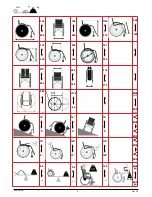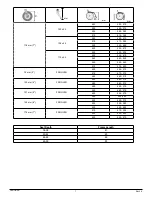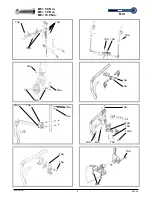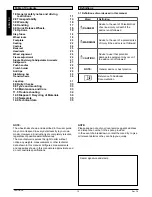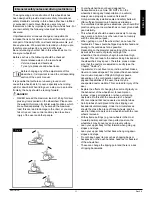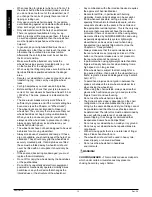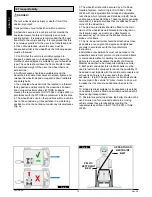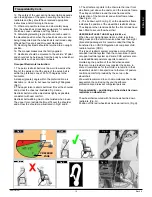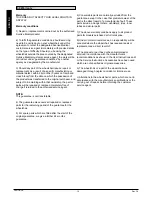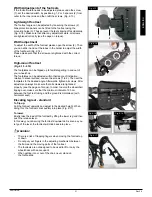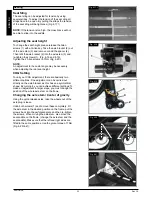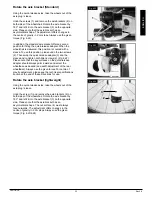
•
When reaching for objects (which are in front of, to
the side or behind the wheelchair) make sure that
you do not lean too far out of the wheelchair, as if
you change the centre of gravity there is a risk of
tipping or rolling over.
•
Only use your wheelchair properly. For example,
avoid travelling against an obstacle without braking
(step, kerb edge) or dropping down gaps.
•
Only attempt stairs with the help of an attendant.
There is equipment available to help you, e.g.
climbing ramps or lifts, please use them. If there is
no such equipment available, then the wheelchair
must be tipped and pushed over the steps (2
helpers).
•
In general, any anti-tip tubes fitted must be set
beforehand, so that they cannot touch the steps, as
otherwise this could lead to a serious tumble.
Afterwards the anti-tip tubes must be set back to
their correct position.
•
Make sure that the attendant only holds the
wheelchair using securely mounted parts (e.g. not
on the footrests or the sideguards).
•
When using the lifting ramp make sure that the anti-
tip tubes fitted are positioned outside the danger
area.
•
Secure your wheelchair on uneven ground or when
transferring (e.g. into a car) by using the wheel
locks.
•
For high amputees you must use anti-tip tubes.
•
Before setting off, check that your tyre pressure is
correct. For rear wheels it should be at least 3.5 bar
( 350 kPa). The max. pressure is indicated on the
tyre.
•
The knee-lever brakes will only work if there is
sufficient tyre pressure and if the correct setting has
been made (see the Chapter on "Wheel locks").
•
The wheel locks are not intended to brake your
wheelchair. They are only there to ensure that your
wheelchair does not begin rolling unintentionally.
When you stop on uneven ground, you should
always use the wheel locks to prevent such rolling.
Always apply both wheel locks; otherwise, your
wheelchair could tip over.
•
The wheel locks have not been designed to be used
as brakes for a moving wheelchair.
•
Always make use of elevators and ramps. If these
are not available, you should request the help of an
attendant. They should only grip the wheelchair at
securely mounted parts. If anti-tip tubes are fitted
these must be folded away. A wheelchair should
never be lifted with an occupant; it should only be
pushed.
•
If the seat and back sling are damaged, you must
replace them immediately.
•
Do not lift or carry the wheelchair by the backtubes
or the pushhandles.
•
Do not fit any unauthorized electronic equipment,
powered or mechanically operated mobility drives,
hand-bike or any other device that changes the
intended use or the structure of the wheelchair.
•
Any combination with other medical devices requires
the approval of Sunrise Medical.
•
Be careful with fire, in particular with burning
cigarettes. Seat and back slings can be set alight.
•
If and whenever possible, during a journey in a
specially fitted vehicle for disabled people, vehicle
occupants should use the seats in the vehicle and
the appropriate restraint system. This is the only way
to ensure that occupants will have the maximum
protection if there is an accident. When using safety
elements offered by SUNRISE MEDICAL and using
a specially designed safety system, lightweight
wheelchairs can be used as a seat when being
transported in a specially fitted vehicle. (See the
Chapter on "Transportation").
•
Always make sure that the quick-release axles on
the rear wheels are set properly and lock in. If the
button on the quick-release axle is not pressed in,
the rear wheel cannot be removed.
•
In particular when using lightweight metal handrims,
fingers will easily become hot when braking from a
high speed or on long inclines.
•
If the wheelchair is subject to direct sunlight for a
long period of time, then parts of the wheelchair (e.g.
frame, legrests, brakes and sideguard) may become
hot (>41°C).
•
To avoid hand injuries do not grab in between the
spokes or between the rear wheel and wheel lock
when driving the wheelchair.
•
When using the chair outside, always wear leather
gloves which will increase your grip and protect the
fingers from dirt and overheating.
•
Do not use the wheelchair on slopes > 10°.
•
The Dynamic safe slope is dependant on the chair
configuration, the users abilities and the style of
riding. As the users abilities and style of riding cannot
be pre-determined then the max safe slope cannot
be determined. Therefore this must be determined by
the user with the assistance of an attendant to
prevent tipping. It is strongly recommended that
inexperienced users have Ant-tips fitted.
•
Do not use your wheelchair on muddy or icy ground.
•
Do not use your wheelchair where pedestrians are
not allowed.
•
With all moving parts there is a natural risk of finger
traps. Please handle with care
•
The wheelchair should not be used in heavy rain,
snow, slippery, or unsound surfaces.
•
Do not use the wheelchair in hazardous
environments.
WARNING!
CHOKING HAZARD –
This mobility aid uses small parts
which under certain circumstances may present a
choking hazard to young children.
12
ENGLISH
Rev.3.0
XENON SA




